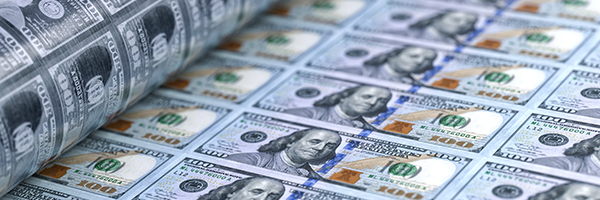
April 25, 2024 | Daily JAM, Mid Term, Morning Briefing |
How views on interest rates have changed since the start of 2024. Then, in January, the consensus view called for as many as six interest rate cuts from the Federal Reserve in 2024 for a total of 150 basis points in cuts to the Fed’s benchmark interest rate. Today, after a dip in first quarter GDP below a 2% annual rate and an uptick in core PCE inflation, the markets are pricing in just 33 basis points in rate cuts and quite possibly no cut until the Fed’s December 18 meeting.

April 24, 2024 | Daily JAM, Morning Briefing |
One down and billions more to go.
Yesterday’s big auction of 2-Year Treasury notes saw rock solid demand that let the day pass without a big, destabilizing drop in prices and a jump in yields. Today, in Round #2, the Treasury is set to auction off $70 billion in five-year notes. So far, at least, the sale looks like it will see solid demand again. Though, can I say, You ain’t seen nothing yet? Treasury is likely to increase its monthly issuance of the seven main notes and bonds (not including TIPS) by nearly 60% in 2024 to $354 billion in August 2024, from the $222 billon it issued in July 2023, according to “Neutral Issuance” scenario in the presentation by the Treasury Borrowing Advisory Committee.

April 21, 2024 | Daily JAM, Mid Term |
It’s been a tough month for Treasuries with yields rising on a re-thinking of when the Federal Reserve might begin to cut interest rates. The yield on the 10-year Treasury closed at 4.62% on Friday. That’s an increase in yield of 35 basis points in a month. (When yields climb, bond prices fall.) And this week the Treasury will auction a combined $183 billion of two-, five- and seven-year Treasury notes. Ans that’s ahead of the latest update on the Personal Consumption Expenditures index, the Federal Reserve’s preferred inflation measure.

April 14, 2024 | Daily JAM, Short Term |
After Israel and its allies (with the help of some Arab states that don’t want to see a wider Middle East war and who aren’t thrilled with the growing power of Iran and its proxies) succeeded in shooting down almost all of the drones (170), ballistic missiles (120), and cruise missiles (30) launched by Iran against the country, will the two sides both declare victory and claim that honor is satisfied or will one or the other escalate the war with another round of attacks? As of early Monday trading in Asia, the oil and gold markets have reacted with concern but not panic. Gold, up 13% already this year to a record above $2,400 an ounce, moved higher but the gains were relatively modest. Spot gold climbed 0.8% to $2,361.92 an ounce as of 6:20 a.m.in Singapore. The global oil market opened to the upside but by less than 1%. And prices have been steady to slightly weaker since then.

April 8, 2024 | Daily JAM, Morning Briefing |
Yields on the 10-year Treasury rose to the highest since November, climbing to 4.42%. That an increase in the 10-year yield of 25 basis points in the last month. The bond market looks to have given up its hope for three interest rate cuts in 2024 now to be looking now to just two moves by the Federal Reserve in 2024. Wednesday’s release of CPI inflation numbers for March will confirm or reverse that conviction

April 5, 2024 | Daily JAM |
Step 4: Build a short-term Treasury bond ladder The yield on the 10-year Treasury bond climbed another 7 basis points today, April 5. That’s a gain in yield of 23 basis points in one month. So yes, it’s time to build a bond ladder in Treasuries.

February 27, 2024 | Daily JAM, Mid Term, Special Reports |
Can you have your cake and eat it too? That’s basically the question stock investors and traders face now. Is there a way to build a strategy that will put profits in your pocket if the rally that set in at the end of 2023 continues? And that will hedge the downside so the your portfolio won’t tumble if the market does? Or that will at least lose less? Or that might even make some money on its downside bets. I think there is. And that’s the subject of this Special Report. Today Steps 1-3

December 8, 2023 | Daily JAM, Morning Briefing |
The U.S. economy added 199,000 jobs in November, the Labor Department reported today, Friday, November 8. The unemployment rate dropped to 3.7% from 3.9% in October That surprised economists who had expected the unemployment rate to hold steady. The bond market reacted in the morning hours after the report was released at 8:30 a.m. New York time by selling Treasuries. The yield on the 10-year Treasury gained 8 basis points to 4.233% as of 10 a.m. in New York as bond prices fell. The yield on the two-year Treasury jumped 78 basis points to 4.669%.

November 15, 2023 | Daily JAM |
Today stocks and bonds both paused to think about yesterday’s huge rally.

October 11, 2023 | Daily JAM, Dividend Income, Long Term, Morning Briefing, Volatility |
“Nobody expects the Spanish Inquisition!” Monty Python observed back in 1970 before attempting to torture a coal-miner’s wife with a dish rack. There’s an important investing version of this core truth: The financial market usually worries about the wrong problem. So that when the “Spanish Inquisition” (in financial terms) finally arrives, everybody is surprised. Well, we investors and traders have done it to ourselves again. We’ve spent much of 2022 and a good part of 2023 worrying about whether Federal Reserve interest rate increases would send the economy into a recession. There are still a few recession die hards worrying about that possibility, but by and large the worry has shifted to whether or not the Fed will delay its rate cuts in 2024–and thus delay the arrival of the “rate-cut-bounce.” While MANY–but certainly not all–investors, traders, and market analysts have been looking OVER THERE, however, the credit markets have built up a huge debt overhead and the global debt bomb looks ever closer to exploding. A crisis with the dire effects of the Global Financial Crisis of mid-2007 to 2009 is a possibility. I’d “guess” that most portfolios aren’t ready. The time to get ready is now. This increasingly looks like a debt market crisis of the type known as a Minsky Moment. To get ready first understand the source of the problem. I’m putting together a new Special Report for next week on what to do to get ready. Today’s post is a kind of set up, a get ready for the post on getting ready, if you will.

September 26, 2023 | AAPL, ADBE, ALB, AMAT, EUM, GOLD, LAC, Morning Briefing, MSFT, NVDA, PILBF, RWM, SCCO, Short Term, Special Reports, UUP, Volatility |
So what do you do with your portfolio for the rest of 2023? And what’s your best strategy to be prepared for 2024? In Part 1 of this Special Report I laid out the 10 developments that I thought would drive the financial markets for the rest of 223 and into 2024. Today, in Part 2, I’m going to give you the first 2 of 10 moves to take–with as much detail and as many specifics as possible–that you should be making now to position your portfolio for the uncertainties of the last quarter of 2023.

September 7, 2023 | Daily JAM, Morning Briefing |
Oh, boy, something to look forward to. The Senate returned to session on September 5 and the House will follow on September 12. And a new government shutdown looms. (This is different than the threat of a default on U.S. government debt that was averted by a last-minute deal to raise the debt ceiling. This time the government and agencies such as the Federal Aviation Administration and the Department of Agriculture would simply hang closed signs on their doors until Congress appropirated money for operations.)
The timing has a good likelihod of disrupting a clear trend in the financial markets.









